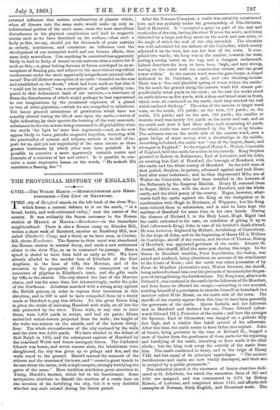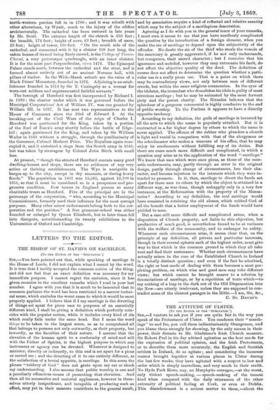THE PROVINCIAL HISTORY OF ENGLAND.
cvni.—THE WELSH MARCH :—MONMOUTHSHIRE AND HERE- FORDSEURE.—THE CITY OF HEREFORD. THE city of Hereford stands on the left bank of the river Wye, which forms a natural defence to it on the south, "in a broad, fertile, and well-cultivated valley," near the centre of the county. It was evidently the Saxon successor to the Roman -station at MAGILE or MAGNA —Renchester—in the immediate neighbourhood. There is also a Roman camp on Dinedor Hill, within a short walk of Hereford, another on Backbury Hill, now
Ethelberes Camp, and a third, as we have seen, at Creden- shill, above Kenchester. The Saxons in their usual way abandoned the Roman station to natural decay, and made a new settlement closer to the river Wye, so as to command its passage. Here a eynod is stated to have been held as early as 680. We have already alluded to the murder here of Ethelbert of the East Anglians, in the time of Offa the Mercian, and of the .accession to the prosperity of the town consequent on the -concourse of pilgrims to Ethelbert's tomb, and the gifts made by Offa to the church. The city shared the fate of the Mercian states, and was for some time, but intermittingly, under the yoke -of the Northmen. Athelstan marched with a strong army against the British princes, in order to repress their incursions in this -direction, and in 939 is said to have compelled them by a treaty made at Hereford to pay him tribute. To this great Saxon king is given the credit of enclosing Hereford with walls, on all but the side protected by the river. These walls, at any rate in later times, were 1,800 yards in extent, and had six gates ; fifteen embattled watch-towers projected from the walls ; the height of the walls was sixteen on the outside, and of the towers thirty- four. The whole circumference of the city enclosed by the walls and the river was 2,350 yards. We have alluded to the defeat of Earl Ralph in 1055, and the subsequent capture of Hereford by the combined Welsh and Saxon insurgent forces. The Cathedral Church was burnt, and seven canons slain, the inhabitants were alaughtered, the city was given up to pillage and fire, and the walls razed to the ground. Harold rescued the remnant of the citizens and the remains of the town, and" caused a great trench to be cast about the latter, with a high rampire, strongly fortifying the gates of the same." Here tradition attributes great atrocities to Tostig, Harold's brother, which led to his banishment. Some antiquaries attribute to Harold the erection of a castle here on the occasion of his fortifying the city, but it is very doubtful whether any such existed during the Saxon period.
After the Norman Conquest, a castle was certainly constructed here, and was probably under the governorship of Fitz-Osborne,
Earl of Hereford. It "occupied a space on part of the east and south sides of the city, having the river Wye on the south, and being defended by a large and deep moat on the north and east sides, to the angle of which the wall of the city extended. The situation was well calculated for the defence of the Cathedral, which nearly adjoined it on the west, but not for that of the town. It com- prised two wards ; the keep was in the smaller, towards the west, having a strong tower on the top, and a dungeon underneath. Leland describes the keep to have been 'high, and very strong, having on the outer wall ten semicircular towers, and one great tower within.' In the eastern ward were the gate-house, a chapel dedicated to St. Cuthbert, a mill, and two dwelling-houses. There was a fine and plentiful spring of water within the castle.' On the south the ground along the eastern ward fell almost per- peudicularly seven yards to the river ; on the east the works stood on earth thrown up five yards, with a deep and broad moat in front, which were all continued on the north, until they reached the wall which enclosed the keep." The sides of the eastern or larger ward were, on the south, 175 yards ; on the west, 100 yards ; on the north, 175 yards ; and on the east, 196 yards ; the smaller or western ward was nearly 100 yards on the south and east, and on the north and west it had three sides, each measuring 65 yards. The whole castle was once environed by the Wye or by brooks. The entrance was on the north side of the eastern ward, over a great bridge of stone arches, with a drawbridge in the middle. According to Leland, the castle was "one of the largest, finest, and strongest in England." In the reign of Henry I., Walter, Constable of England, held the castle for a time in his custody. King Stephen granted to Robert de Bellamonte, Earl of Leicester, and his heirs, on creating him Earl of Hereford, the borough of Hereford, with the castle and the whole county of Hereford. In the civil wars of that period, Stephen, in person, advanced against and took Here- ford after some resistance ; and he then dispossessed Milo, son of Walter the Constable, who had been installed in the honours of the Bellmonts by the Empress Matilda. Henry II. restored them to Roger, Mb's son, with the mote of Hereford, and the whole castle, and the third penny of the county. Roger, however, after- wards held the castle against the King at the instigation or in combination with Hugh de Mortimer, of Wigutore ; but the King soon reduced them to submission, and is said to have kept the earldom of Hereford for some time in his own hands. During the absence of Richard L in the Holy Land, Hugh Bigod had the castle entrusted to his care, on condition of giving it up to Earl (afterwards King) John in case of his brother's death abroad. He was, however, displaced by Hubert, Archbishop of Canterbury. In the reign of John, and in the beginning of Henry III.'a, William de Cantilupe, sheriff of the county, and brother of Thomas, Bishop of Hereford, was appointed governor of the castle. Almeric St. Amend, also sheriff, filled the same post during this reign. In the Simon de Montfort troubles, Peter Aquablanca, the bishop, was seized and confined, being obnoxious on account of his attachment to the Court of Rome ; and the castle was taken possession of by Peter de Montfort (Leicester's son), Walter Devereu, the sheriff, being ordered to hand him over the proceeds of thecounty for the pur- pose of strengthening the fortifications. The King's son, afterwards Edward L, was confined in the caatleby the followers of De Montfort, and from hence he effected his escape,—according to one account, availing himself of a permission to exercise himself on horseback in a meadow called Wide Marsh, on the north side of the town. The sheriffs of the county appear from this time to have been generally the governors of the castle. Queen Isabella and her followers met in Hereford and declared her son, Prince Edward (after- wards Edward Protector of the realm ; and here the younger De Spencer, Earl of Gloucester, was hanged on a gallows fifty feet high, and a similar fate befell several of his adherents. After this time, the castle seems to have fallen into neglect. John of Gaunt, being governor in the time of Richard II., begged a store of timber from the gentlemen of those parts for the repairing and fortifying of the castle, intending to have made it his chief abode; but the king took away the custody of the castle from him. The castle continued to decay, and in the reign of Henry VIII. had lost many of its principal appendages. "The ancient fortifications and castle are now wholly destroyed, and their site is occupied by a public promenade."
The cathedral church is the successor of Saxon churches dedi- cated to St. Ethelbert, for which the successive dates of 825 and 1030 are assigned, and was commenced in 1079 by Bishop Robert, of Lorraine, and completed about 1115, and affords rich examples of Norman, Early English, and Decorated work. The
north-western portion fell in in 1786; and it was rebuilt with other alterations, by Wyatt, much to the injury of the edifice architecturally. The cathedral has been restored in late years by Mr. Scott. The extreme length of the church is 350 feet ; the breadth, 174 feet ; height of nave, 63 feet ; breadth of nave, 23 feet; height of tower, 160 feet. "On the south side of the cathedral, and connected with it by a cloister 109 feet long, the oaken beams of its roof being finely carved, is the College of Vicars- Choral, a very picturesque quadrangle, with an inner cloister. It is for the most part Perpendicular, circa 1474. The Episcopal Palace stands south, between the cathedral and the river, and is formed almost entirely out of an ancient Norman hall, with pillars of timber. In the Wide-Marsh suburb are the ruins of a Black Friars' Monastery, founded in 1276. Adjoining is an estab- lishment founded in 1614 by Sir T. Coningsby as a retreat for worn-out soldiers and superannuated faithful servants."
The borough of Hereford was first incorporated by Richard I. in 1189; the charter under which it was governed before the Municipal Corporations' Act of William IV. was one granted by William III. in 1697. It has sent two representatives to the rouse of Commons since the 23rd of Edward I. At the breaking-out of the Civil Wars of the reign of Charles I. Hereford was garrisoned for the King, taken by a portion of the Earl of Essex's army shortly before the battle of Edge- hill ; again garrisoned for the King, and taken by Sir William Waller in 1643 without a struggle, through the pusillanimity of the Governor, Colonel Herbert Price. The Royalists again reoc- cupied it, and it sustained a siege from the Scotch army in 1645, but was taken by stratagem by Colonel John Birch with small loss.
At present, "though the streets of Hereford contain many good dwelling-houses and shops, there are no evidences of any very active or thriving establishments. The Wye is navigable in barges up to the city, except in dry summers, or during heavy floods." The population in 1861 was 15,585, against 12,108 in 1851, so that it must be considered as in a prosperous and pro- gressive condition. Few towns in England possess so many charitable trusts as Hereford. Five of the principal are in the patronage of the corporation, "who, according to the Municipal Commissioners, formerly used their influence for the most corrupt purposes. Many other minor endowments belong both to the cor- poration and the parishes." A free grammar-school was either founded or enlarged by Queen Elizabeth, but in later times fell into disrepute, notwithstanding its twenty exhibitions to the Universities of Oxford and Cambridge.































 Previous page
Previous page